Tagmaster XTXX RFID reader User Manual Manual
Tagmaster AB RFID reader Manual
Manual
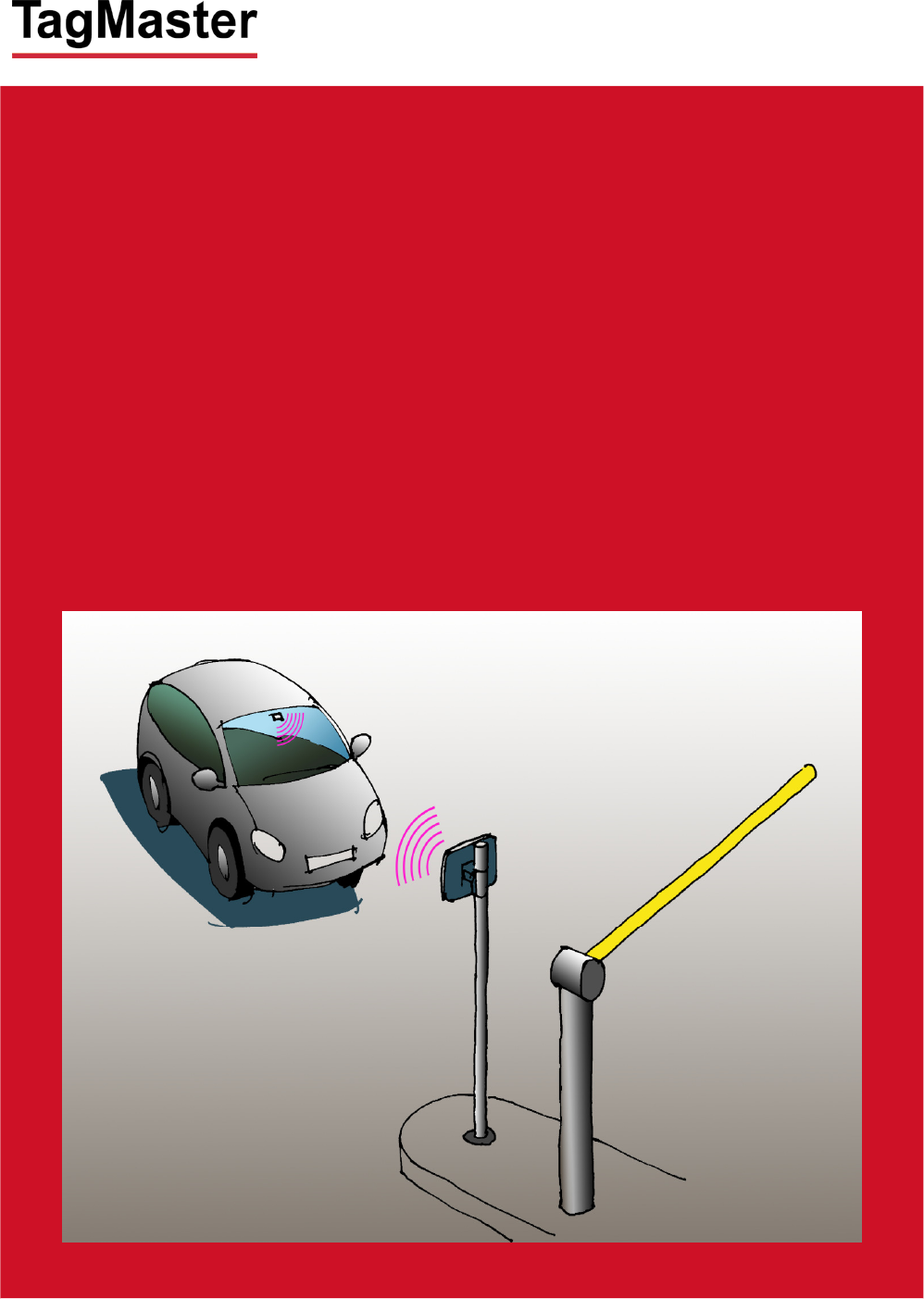
XT-1
Installation Manual

XT-1 Installation Manual 13-111 P01B, 2013-RO-0XX, 2014-01-28
Page 2 of 32
Note: This equipment has FCCID: M39XTXX. It complies with the limits for a Class A digital device,
pursuant to part 15 of the FCC Rules. These limits are designed to provide reasonable protection against
harmful interference when the equipment is operated in a commercial environment. This equipment
generates, uses, and can radiate radio frequency energy and, if not installed and used in accordance with
the instruction manual, may cause harmful interference to radio communications. Operation of this
equipment in a residential area is likely to cause harmful interference in which case the user will be
required to correct the interference at his own expense.
Caution: Changes or modifications not expressly approved by the party responsible for compliance could
void the user’s authority to operate the equipment.
Caution: To comply with Council Recommendation 1999/519/EC and FCC regulations, this reader must be
installed to provide a separation distance of at least 25 cm from all persons and must not be co-located or
operating in conjunction with any other antenna or transmitter.
Copyright
The copyright and ownership of this document belongs to TagMaster AB. The document may be
downloaded or copied provided that all copies contain the full information from the complete document. All
other copying requires a written approval from TagMaster AB.
Disclaimer
While effort has been taken to ensure the accuracy of the information in this document TagMaster AB
assumes no responsibility for any errors or omissions, or for damages resulting from the use of the
information contained herein. The information in this document is subject to change without notice.
XT-1 Installation Manual 13-111 P01B, 2013-RO-0XX, 2014-01-28
Page 3 of 32
Content
1 Introduction 4
Overview........................................................................................................ 4
1.1
Tags .............................................................................................................. 4
1.2
Security ......................................................................................................... 4
1.3
2 Installation 4
Safety Instructions ......................................................................................... 4
2.1
Mounting Instruction ...................................................................................... 4
2.2
3 Interfaces 6
Cables ........................................................................................................... 6
3.1
Wires ............................................................................................................. 8
3.2
3.2.1
Terminal Connections .................................................................................... 8
3.2.2
Ethernet and USB .......................................................................................... 8
Power Supply ................................................................................................ 9
3.3
Wiegand/Magstripe ...................................................................................... 10
3.4
3.4.1
Wiegand Timing ........................................................................................... 11
3.4.2
Magstripe Timing ......................................................................................... 12
Ethernet ....................................................................................................... 13
3.5
RS232 ......................................................................................................... 14
3.6
RS485 ......................................................................................................... 15
3.7
USB ............................................................................................................. 17
3.8
Input ............................................................................................................ 18
3.9
Output .......................................................................................................... 19
3.10
Relay ........................................................................................................... 20
3.11
DIP Switches ............................................................................................... 21
3.12
3.12.1
DIP SW S101 .............................................................................................. 21
3.12.2
DIP SW S301 .............................................................................................. 21
LED and Buzzer........................................................................................... 22
3.13
4 Configuration 22
PC Tool ....................................................................................................... 22
4.1
Settings ....................................................................................................... 22
4.2
Reset to Factory Default .............................................................................. 22
4.3
5 TAGP 22
6 Trouble Shooting 23
7 Technical Specification 31
XT-1 Installation Manual 13-111 P01B, 2013-RO-0XX, 2014-01-28
Page 4 of 32
1 Introduction
Overview
1.1
The XT-1 is an UHF RFID reader compliant with EPC Gen 2 (ISO 18000-6C). The reader is specifically
tailored for Automated Vehicle Identification (AVI) applications such as Parking, Gated Communities and
Condominiums. It has been designed for absolutely premium performance for read-range and
environmental specification while also giving a large number of interface options and having an innovative
implementation for TCP/IP connectivity and monitoring.
Tags
1.2
XT-1 supports any UHF tag compliant with the EPC Gen 2 standard. XT-1 also supports the
SecureMarkID
®
format developed by TagMaster to ensure that each tag has a truly unique identity difficult
to duplicate.
Security
1.3
The EPC Gen 2 standard was initially developed for low cost item management and has for that reason no
built in support for encryption like DES or AES. This differentiates the system from for instance many
proximity identification systems. To address this TagMaster has developed the SecureMarkID
®
format
using a specific algorithm and non-writeable parts of the tag to create a truly unique identity difficult to
duplicate. It is recommend to only use SecureMarkID
®
tags together with XT-1, but also to consider these
limitations in any application requiring high security.
As the development of a cryptographic framework for EPC Gen2 proceeds, TagMaster will offer future new
products to continue to make the most of available technology in an effort to offer the highest possible
security.
2 Installation
Safety Instructions
2.1
The following safety instruction should be observed during installation, normal use and service.
The installation and service should only be done by qualified personnel.
Shields of cables should be connected to safety ground.
The XT-1 must be disconnected from all voltage sources before any installation or service work.
Capacitors inside the XT-1 can hold their charge even if the equipment has been disconnected from
all voltage sources.
Do not modify any part of the product. Repair is to be performed by TagMaster only.
Where local regulations exist, these are to be followed. The safety information in this manual is a
supplement to local regulations. It is the responsibility of the local project manager to make certain
that local regulations are known and followed.
Mounting Instruction
2.2
The XT-1 can be mounted to a wall or a pole, see Figure 1. Mount the reader in a horizontal position with
the cable glands on the bottom side. Direct the reader so that the reading lobe covers the positions of the
tags. For optimal performance, tilt and rotate the reader into a position so that the front side of the reader is
parallel with the front side of the tag to be read. Align the reader so that the actual reading range is 60–70%
of the specified maximum.
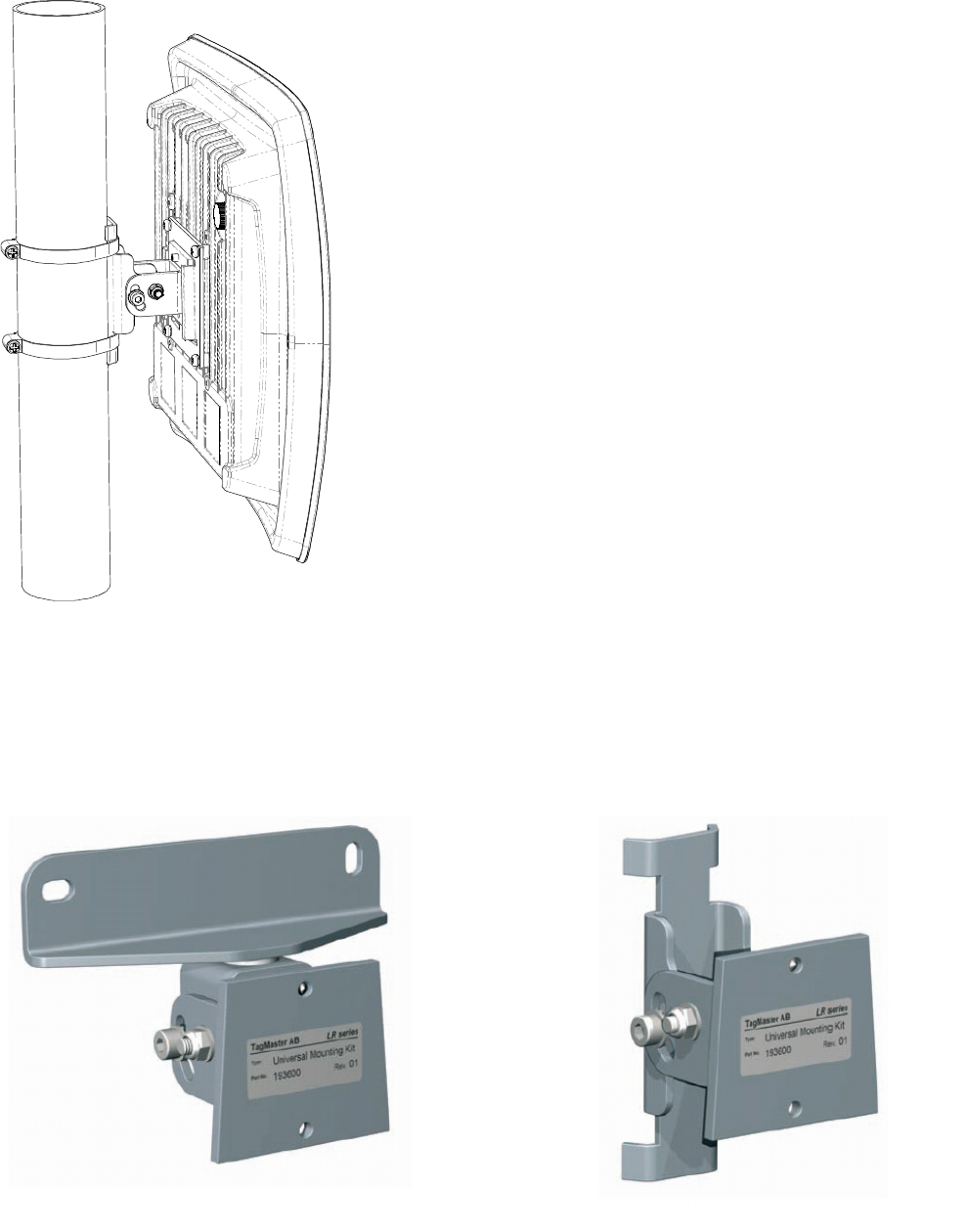
XT-1 Installation Manual 13-111 P01B, 2013-RO-0XX, 2014-01-28
Page 5 of 32
Figure 1 XT-1 mounted on a pole using UMK
The UMK (Universal Mounting Kit, Part No. 193600), see Figure 2, from TagMaster enables the reader to
be mounted in a wide variety of positions and angles. The kit contains all parts needed for mounting the
reader on a wall or on a pole. The UMK is suitable for outdoor use. See separate data sheet for more
details on installation.
Figure 2 UMK for wall and pole mounting of XT-1
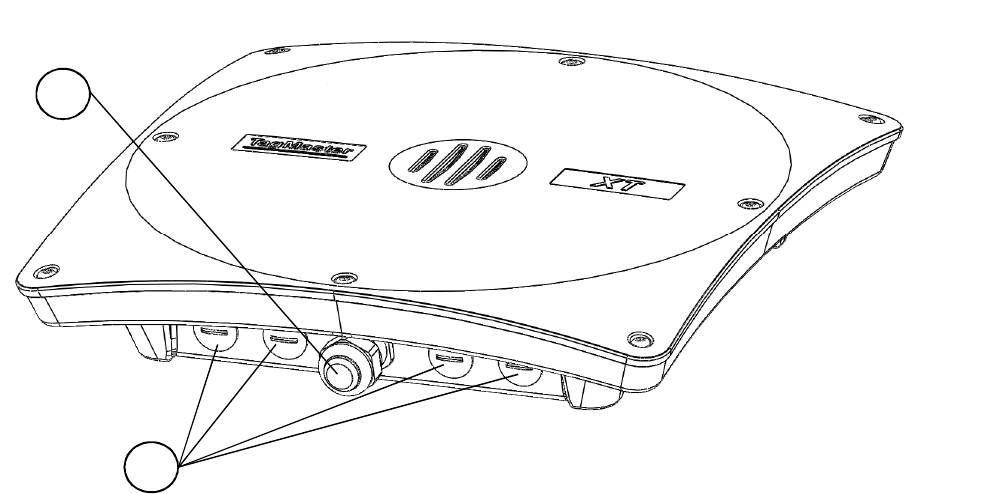
XT-1 Installation Manual 13-111 P01B, 2013-RO-0XX, 2014-01-28
Page 6 of 32
3 Interfaces
Cables
3.1
Connections to the XT-1 is primarily done using the central M20 cable gland, and secondarily by replacing
any of the 4 pcs of M16 blind stops with cable glands, see Figure 3. Shielded cables should be used for all
connections. Select cables suitable for the installation environment, considering indoor or outdoor
environment and use flexible cables with stranded wire. The reader chassis should be grounded.
Figure 3 Cable connections for XT-1 (Pos. 1 is M20 cable gland, Pos. 2 is M16 blind stops)
Instructions:
1. Select and use the M20 cable gland insert corresponding to the number of cables required. The
cable gland can be used with one cable (6-12 mm) or by using the supplied insert with two cables
(2-6 mm), see Figure 4.
2. Open XT-1 lid by removing the 8 screws on the front, and slide the lid open.
3. Feed the cable (or two cables) through the cable gland and through the chassis. All parts of the
cable gland except the nut shall be on the outside of the XT-1.
4. Connect the wires to relevant terminals and connections depending on interfaces being used. If
using RJ45 connectors for Ethernet these must be crimped inside the reader.
5. Connect the shielding of the power cable to the chassis grounding point using the grounding screw
(Figure 5, Pos. 1).
6. Screw the cable gland to tighten and ensure proper water and dust sealing.
As an alternative for grounding, a metallic cable gland (not included) can be used to connect to the reader
chassis to ground using the power cable shielding.
1
2
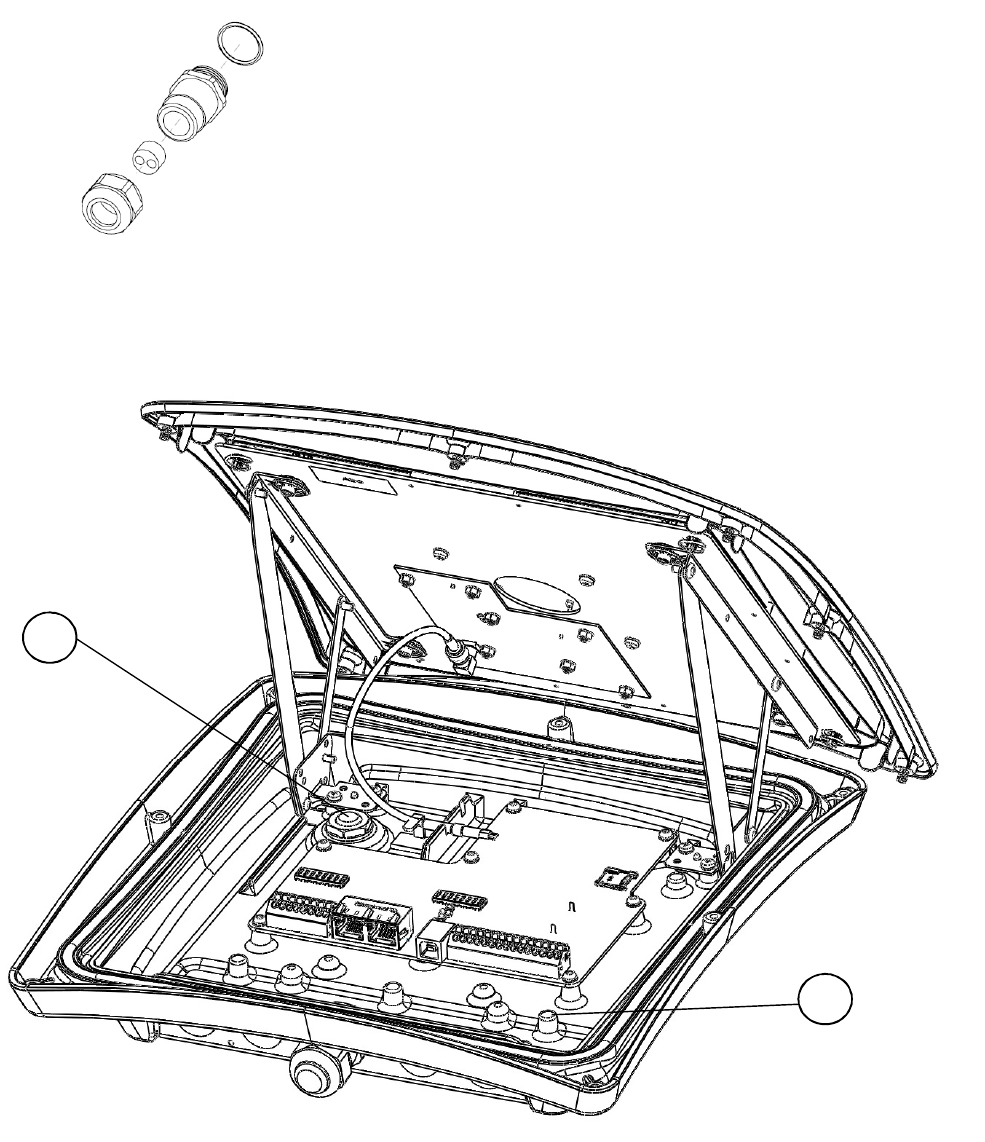
XT-1 Installation Manual 13-111 P01B, 2013-RO-0XX, 2014-01-28
Page 7 of 32
Figure 4 The XT-1 M20 cable gland with insert for 2 cables
Never use the ventilating membrane (Figure 5, Pos. 2) on the back of the XT-1 for cable connections.
Figure 5 XT-1 overview (Pos. 1 is ground screw connection, Pos.2 is ventilating membrane)
1
2
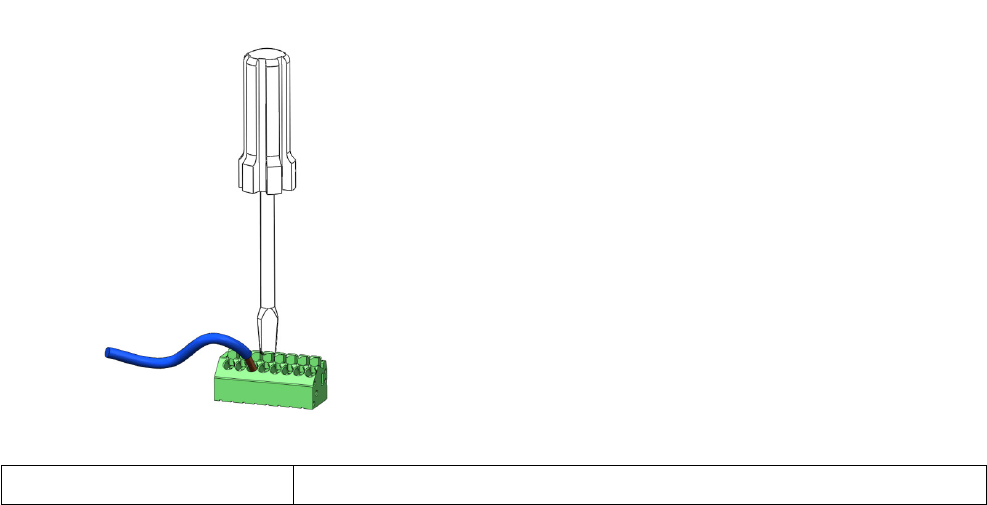
XT-1 Installation Manual 13-111 P01B, 2013-RO-0XX, 2014-01-28
Page 8 of 32
Wires
3.2
3.2.1 Terminal Connections
Wire connections (with the exception of Ethernet and USB, see §3.2.2) are added as singles wires to spring
cage terminal connectors, see Figure 6. These are easy-to-use terminals for single stranded wires.
Instructions:
1. Strip wire lead approximately 9 mm.
2. Push screwdriver down to release spring cage.
3. Insert wire into terminal.
4. Remove screwdriver which will clamp wire.
5. Gently pull installed wire to make sure connection is reliable.
Figure 6 Connection with easy-to-use spring cage terminal
Wire size 0.5mm
2
- 1.5mm
2
/ AWG20 - AWG 16
Table 1 Wire connection overview
3.2.2 Ethernet and USB
Ethernet is connected using RJ45 connectors. To be able to fit this connector given the limited diameter of
M20 cable gland and the hole in the chassis, such RJ45 must be crimped to the wires inside the reader.
This is done with corresponding standard tool and RJ45. Pass the Ethernet cable through the cable gland
before crimping the connector on the cable.
USB is intended for service interface and therefore connected only when lid is open. Connection is done
using a standard USB type B cable.
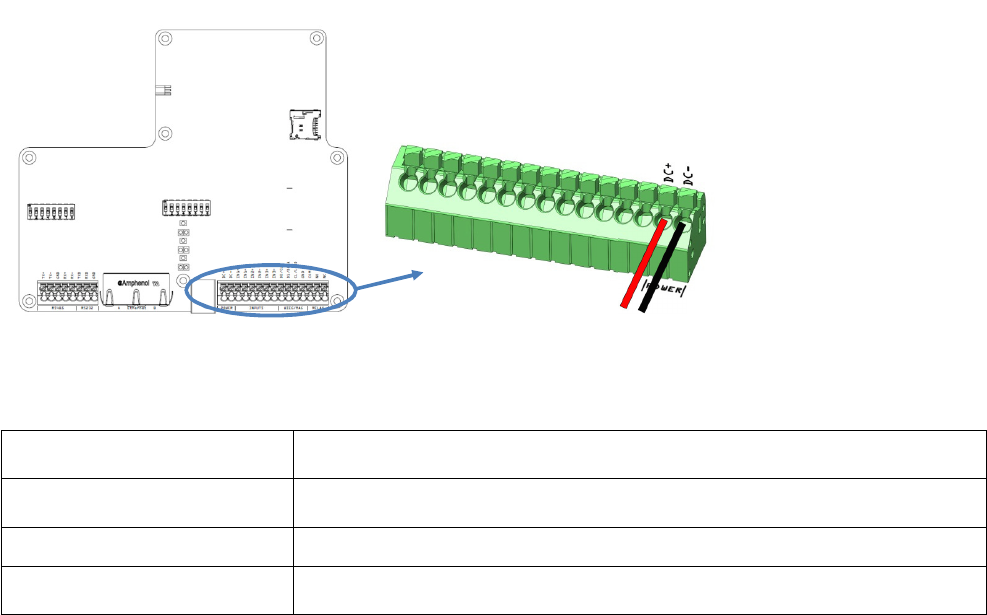
XT-1 Installation Manual 13-111 P01B, 2013-RO-0XX, 2014-01-28
Page 9 of 32
Power Supply
3.3
The XT-1 shall be powered by an isolated power supply suitable for outdoor use. The required voltage is 12
VDC to 24VDC. It is recommended to use a power supply of 24 VDC, 1 A minimum.
Figure 7 Power supply connection, overview and detail
The power input has built-in protection for an accidental connection of reversed polarity.
Connections
DC+
High supply potential
(See
Figure
7
for details
)
DC- Low supply potential
Supply voltage 12 VDC to 24 VDC
(Absolute minimum rating 10 VDC, absolute maximum rating 30 VDC)
Recommended / Max length 10m / 100m
Wire size Recommended length 0.5mm
2
/ AWG 20
Max length 1.5mm
2
/ AWG 16
Table 2 Power connection overview
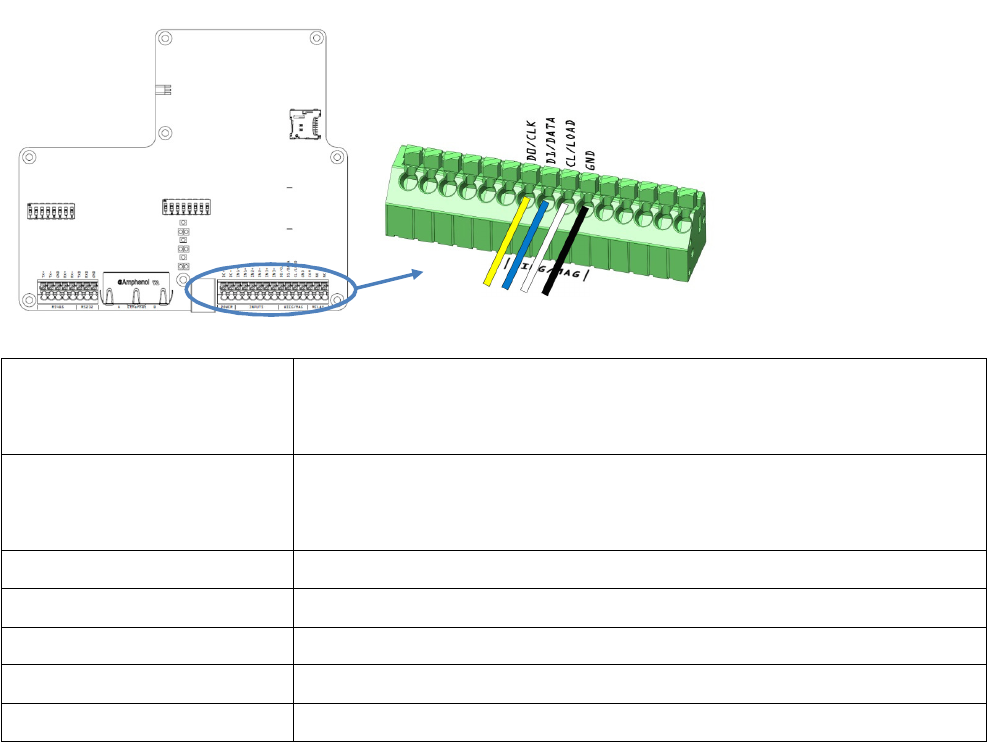
XT-1 Installation Manual 13-111 P01B, 2013-RO-0XX, 2014-01-28
Page 10 of 32
Wiegand/Magstripe
3.4
The Wiegand interface is shared with Magstripe and outputs. This selection of interface is done via SW
configuration see §4. Furthermore is the details of the Wiegand output format configured using SW. The
interface has a separate isolation of 1500 VDC and varistor protection for over voltage.
The XT-1 has a built-in option (3xDIP) of 1k
Ω
pull-ups on the transmit side for D0/CLK, D1/DATA and
CL/LOAD. The DIP switches are also described in §3.12.
Figure 8 Wiegand connection, overview and detail
Connections
(Wiegand)
D0 Wiegand 0 (See Figure 8 for details)
D1 Wiegand 1
CL Card Load
GND Ground
Connections
(Magstripe)
CLK Magstripe clock (See Figure 8 for details)
DATA Magstripe data
LOAD Card load
GND Ground
Recommended / Max length 10m / 100m (depending on properties of receiving system)
Wire size 0.5mm
2
/ AWG 20
Voltage 30 V (Max)
Sink current 50 mA (Max)
Isolation 1500 VDC (Min)
Table 3 Wiegand connection overview
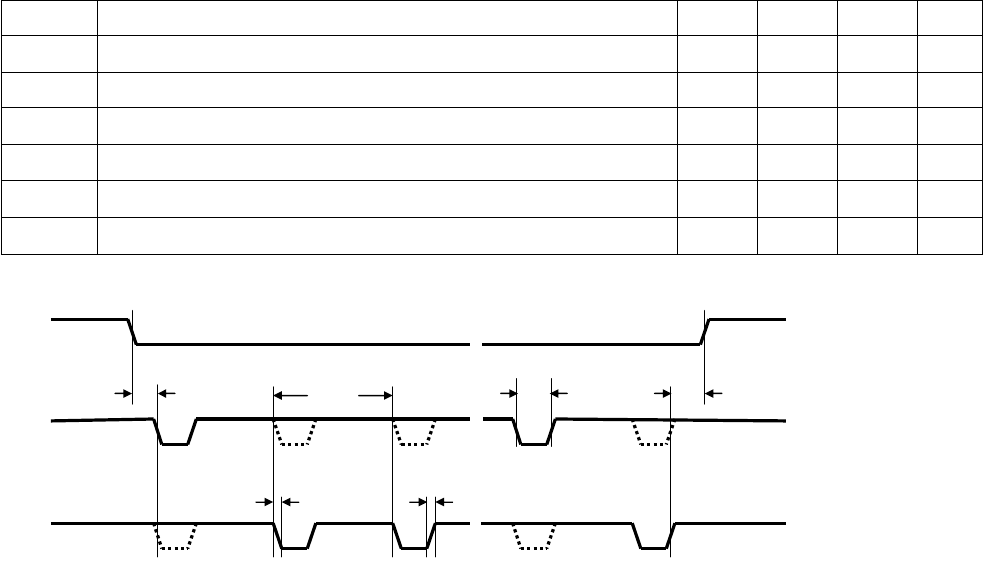
XT-1 Installation Manual 13-111 P01B, 2013-RO-0XX, 2014-01-28
Page 11 of 32
3.4.1 Wiegand Timing
The following values apply when all outputs are pulled up to 5V with 1kΩ resistors.
Symbol
Parameter
Min
Typ
Max
Unit
tSU CL to D# setup time 0
µ
s
t
F
Fall time (all signals) 125 ns
tR Rise time (all signals) 5 µs
t
PI
Pulse interval 2 ms
t
PW
Pulse width
80
µ
s
t
H
CL hold time after
last D# change
0
µ
s
Table 4 Wiegand interface timing
t
SU
t
PI
t
PW
t
H
t
R
t
F
CL
D0
D1
≈ ≈ ≈
Figure 9 Wiegand timing diagram
Description on default output format to be added in later revision.
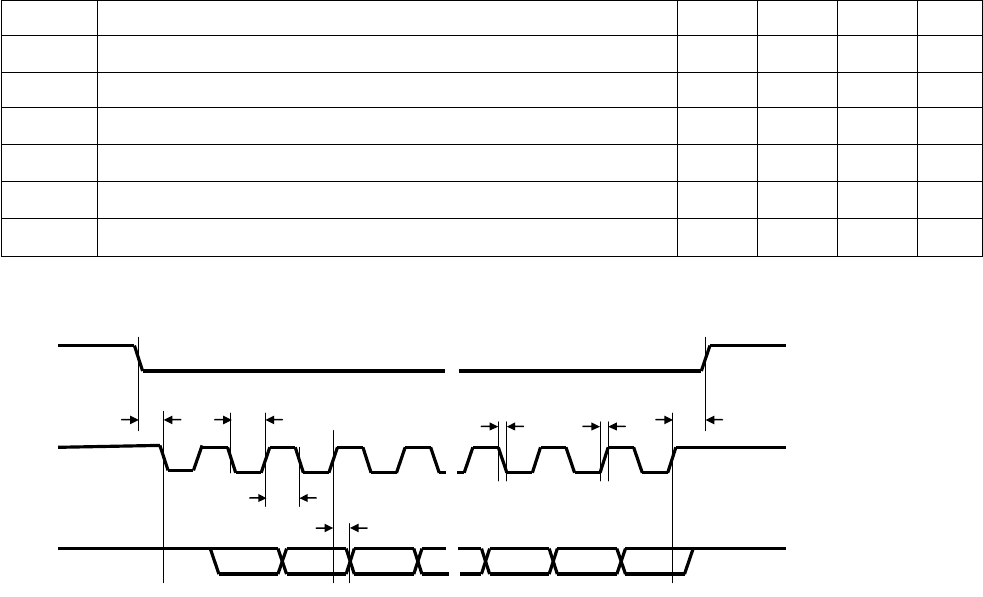
XT-1 Installation Manual 13-111 P01B, 2013-RO-0XX, 2014-01-28
Page 12 of 32
3.4.2 Magstripe Timing
The following values apply when all outputs are pulled up to 5V with 1kΩ resistors.
Symbol
Parameter
Min
Typ
Max
Unit
tSU LOAD to CLK setup time 0
µ
s
t
F
Fall time (all signals) 125 ns
tR Rise time (all signals) 5 µs
tCL Clock low 160 µs
t
CH
Clock high
16
0
µ
s
t
H
LOAD hold time after last CLK change
0
µ
s
Table 5 Magstripe interface timing
≈
≈
t
SU
LOAD
CLK
DATA
≈
t
CL
t
CH
t
DH
t
H
t
R
t
F
Figure 10 Magstripe timing diagram
Description on default output format to be added in later revision.
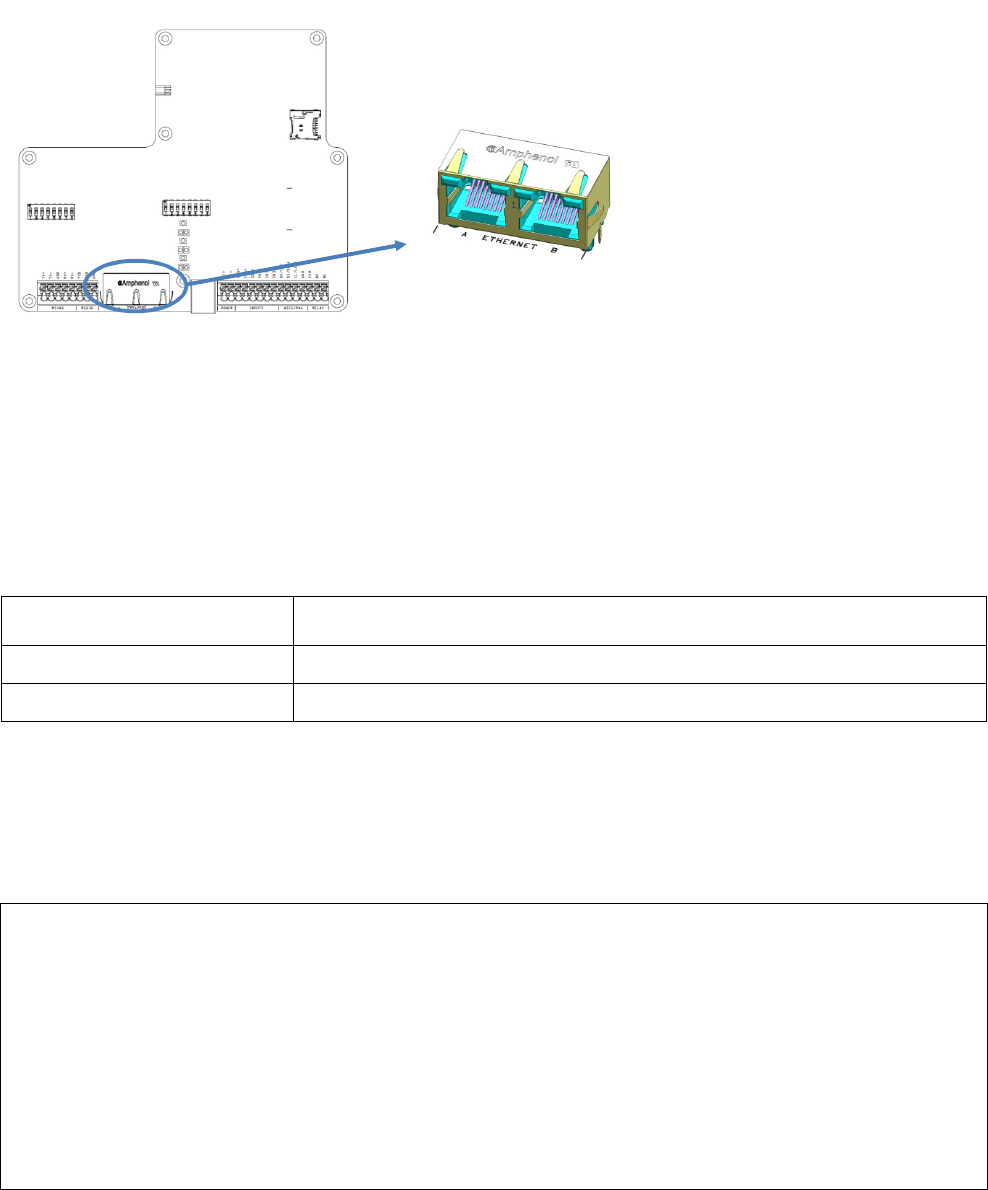
XT-1 Installation Manual 13-111 P01B, 2013-RO-0XX, 2014-01-28
Page 13 of 32
Ethernet
3.5
The XT-1 has a built in 10Mbps/100Mbps Ethernet switch and dual ports. This makes it possible to connect
a number of readers in a system without the need for additional network equipment. The two ports A and B
are using RJ45 connectors and are fully equivalent.
Figure 11 Ethernet connection, overview and detail
The XT-1 supports auto crossover (Auto-MDIX) so that installation can be done using both patch and
crossover cables. The connectors have eight pins and the wire scheme is based on the T568A standard.
The interfaces have separate isolation of 1500 VDC.
The default IP address of the device is unique among XT-1 readers and can be found on the label on the
back of the XT-1. This makes it possible to create a stand-alone network without changing any reader
network settings. Detailed network settings are configured using SW, see §4. Each port has two LED
indicators for Link/Activity (Yellow/Flashing Yellow) and 10Mbps/100Mbps speed (Off/Green).
Connections A Port A (See Figure 11 for details)
B Port B
Recommended / Max length - / 100m
Wire size CAT5e cable is required for the Ethernet connection
Table 6 Ethernet connection overview
Ethernet communication is normally done using TagMaster protocol TAGP available at port 9999. See
Manual 05-172 TAGP Protocol Specification for details.
Example:
The following is an example on how a connection using Ethernet, TCP/IP and TAGP can be tested
1. Download PUTTY-TE from TagMaster ftp-server ftp://partner:245ghz@ftp.tagmaster.com
2. Open a connection with PUTTY-TE using the IP address of the XT-1 and selecting TAGP
3. Write the following sequence to get a 2.5s beep from the reader:
User input XT-1 response
HELOTAGP/2.0 RPLYHELO00
PUSHBEEP9C9 RPLYPUSH00
Table 7 Ethernet connection example
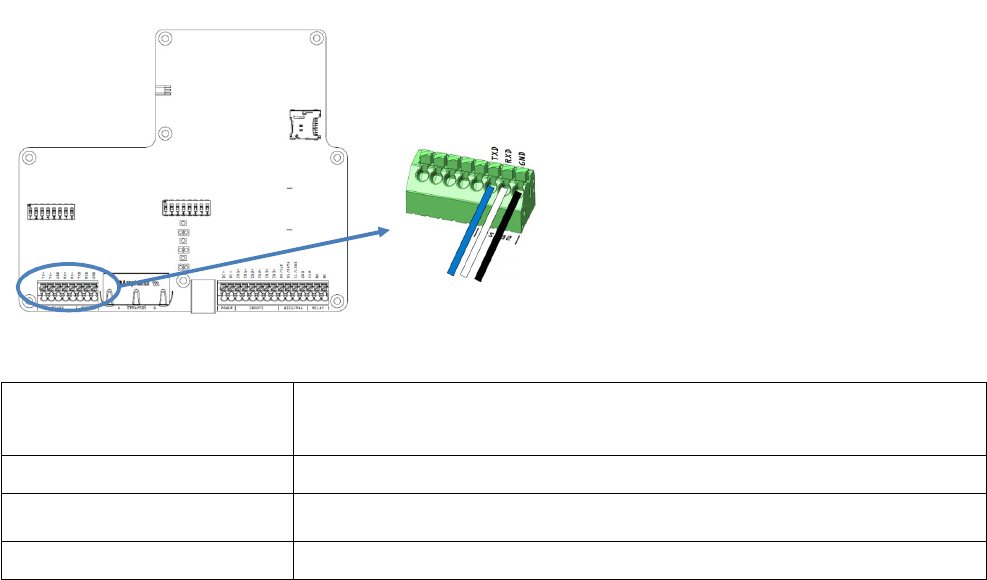
XT-1 Installation Manual 13-111 P01B, 2013-RO-0XX, 2014-01-28
Page 14 of 32
RS232
3.6
The RS232 interface is used for host communication and supports ASCII output and TAGP. Detailed
settings are configured using SW, see §4. The interface has a separate isolation of 1500 VDC and varistor
protection for over voltage.
Figure 12 RS232 connection, overview and detail
Connections
TXD Transmitted data to host (See Figure 12 for details)
RXD Received data from host
GND Ground
Recommended / Max length - / 10m
Wire size
Specification according to EIA RS232C. Belden 9184 or Belden 9502 are
recommended.
Max Baud Rate 115.2 kb/s (default)
Table 8 RS232 connection overview
The default output of the RS232 interface is a one directional ASCII output of tag data. If SecureMarkID®
tags from TagMaster are being used (recommended) this identity is sent followed by CR+LF ('\r''\n'). If other
EPC tags are being used the default output is the EPC data followed by CR+LF ('\r''\n').
As an alternative can TAGP be selected as format if configured using SW.
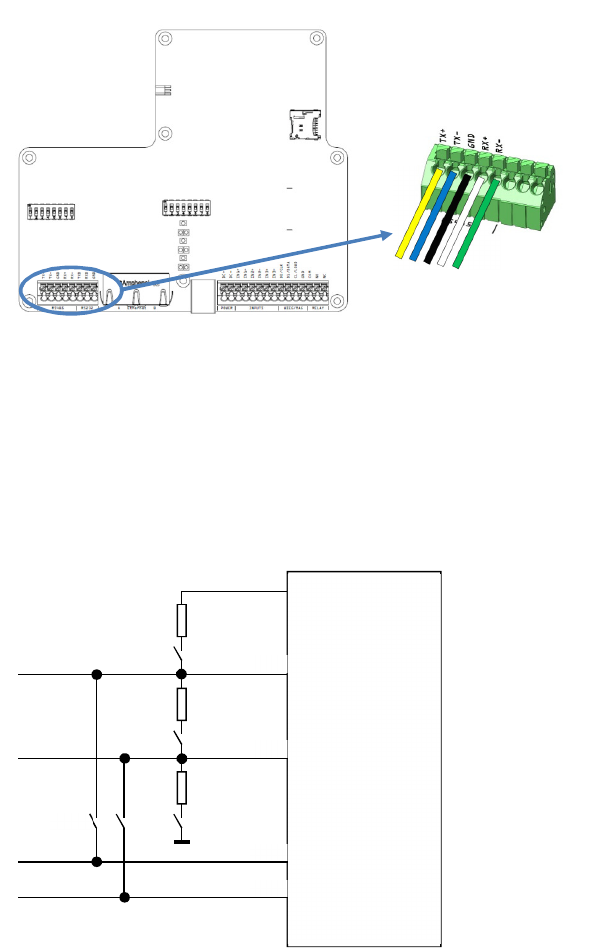
XT-1 Installation Manual 13-111 P01B, 2013-RO-0XX, 2014-01-28
Page 15 of 32
RS485
3.7
The RS485 interface is used for host communication and supports ASCII output and TAGP. It generally
supports longer transmission distances than RS232. Detailed settings are configured using SW, see §4.
The interface has a separate isolation of 1500 VDC and varistor protection for over voltage.
Figure 13 RS485 connection, overview and detail
The hardware supports 2- wire (2xDIP) and 4-wire communication, half duplex and full duplex as well as
multi-drop. When using RS485 communication, correct termination of the interface must always be
considered in order to handle transmission-line effects. The XT-1 has a built-in option (DIP) of 120
Ω
termination on the receive side, and an option (2xDIP) of 600
Ω
bias on receive side. The options using DIP
switches are detailed in Figure 14 and also described in §3.12.
Figure 14 RS485 DIP switch configuration options
RS485
driver
RX+
RX-
TX-
TX+
SW#1
SW#
2
SW#
5
SW#
3
SW#
4
5V iso
120 Ω
620 Ω
620 Ω

XT-1 Installation Manual 13-111 P01B, 2013-RO-0XX, 2014-01-28
Page 16 of 32
Connections
TX+
Transmitted data to host
(See
Figure
13
for details)
TX- Transmitted data to host
GND Ground
RX+ Received data from host
RX - Received data from host
Recommended / Max length - / 1000m
Wire size
The cable for the RS485
interface must be a twisted pa
ir cable and
conform to the EIA RS485 standard.
Max Baud Rate 115.2 kb/s (default)
Table 9 RS485 connection overview
The default output of the RS485 interface is a one directional ASCII output of tag data. If SecureMarkID®
tags from TagMaster are being used (recommended) this identity is sent followed by CR+LF ('\r''\n'). If other
EPC tags are being used the default output is the EPC data followed by CR+LF ('\r''\n').
As an alternative can TAGP be selected as format if configured using SW.
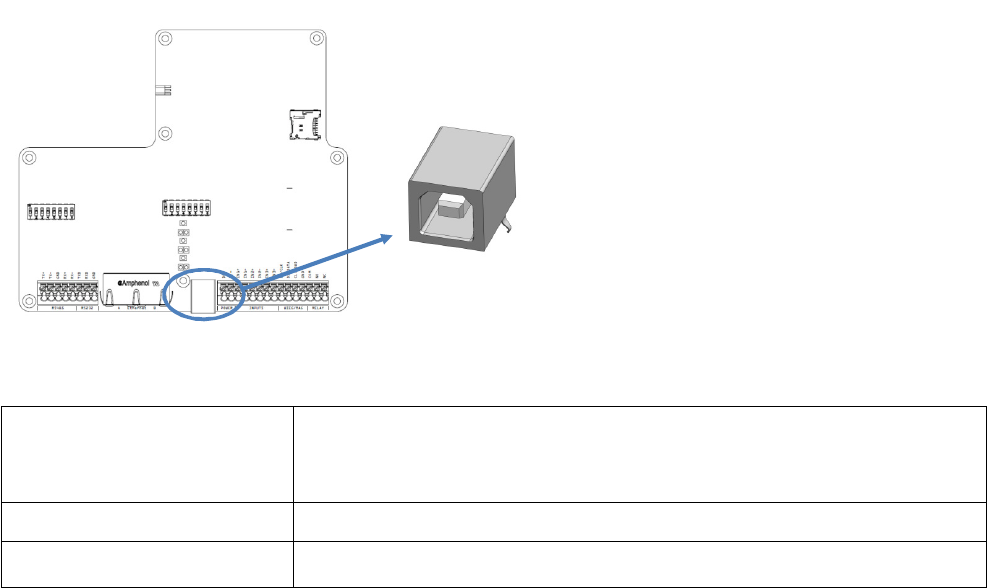
XT-1 Installation Manual 13-111 P01B, 2013-RO-0XX, 2014-01-28
Page 17 of 32
USB
3.8
The XT-1 has one USB type B connector, and acts like a USB 2.0 Full-Speed (12 Mbps) device. This
interface is only intended for configuration and software download (service and maintenance). The interface
is connected using a standard cable to a USB port of a PC, and after installing specific TagMaster software
can maintenance be done, see §4.
Figure 15 USB connection, overview and detail
Connections
VBUS
+5VDC (See
Figure
15
for details)
DM Data–
DP Data+
GND Ground
Recommended / Max length 1m / TBD
Wire size
TBD
Table 10 USB connection overview
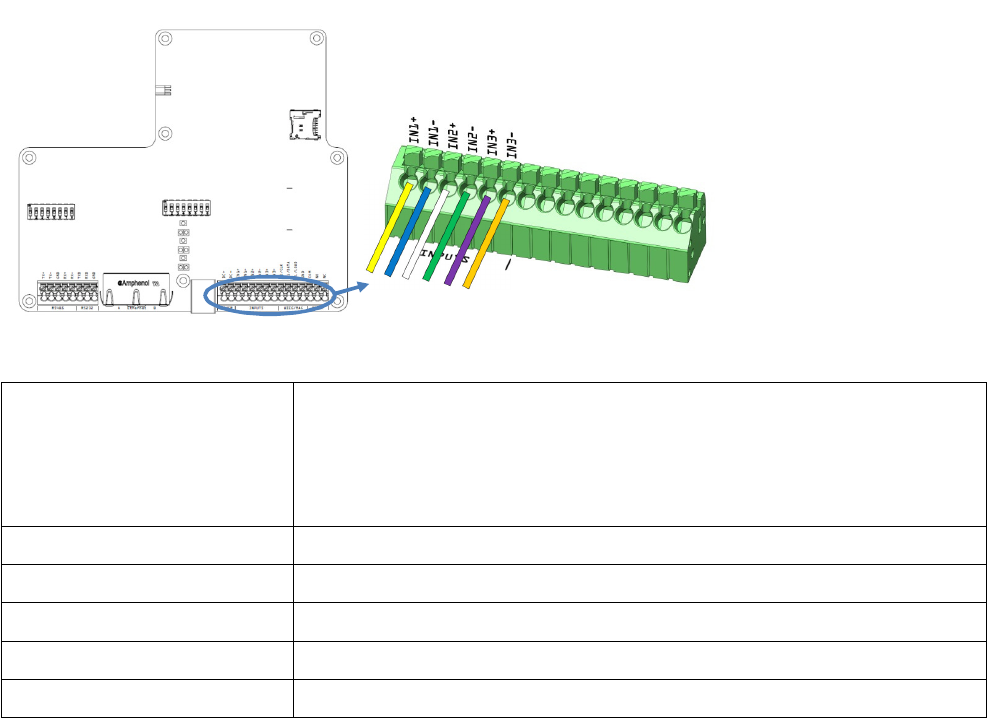
XT-1 Installation Manual 13-111 P01B, 2013-RO-0XX, 2014-01-28
Page 18 of 32
Input
3.9
The XT-1 has 3 inputs available. The inputs are opto-coupled, have 1500VDC isolation and protection for
reversed polarity. They have an input impedance of 1k
Ω
and are activated by a current flow. The inputs are
intended for optional connection to detectors (inductive loop, IR or other type). The types are ‘Presence
detector input’, ‘Safety detector input’ and ‘Opening detector input’.
Figure 16 Input connections, overview and detail
Connections
IN1+
Presence detector input+
(See
Figure
16
for details)
IN1- Presence detector input-
IN2+ Safety detector input+
IN2- Safety detector input-
IN3+ Opening detector input+
IN3- Opening detector input-
High Voltage (active) Min 3.0 V / Max 30 V
Low Voltage (inactive) Min 0.0 V / Max 0.2 V
Input impedance 1 k
Ω
Recommended / Max length 10m / 100m
Wire size 0.5mm
2
/ AWG 20
Table 11 Input connection overview
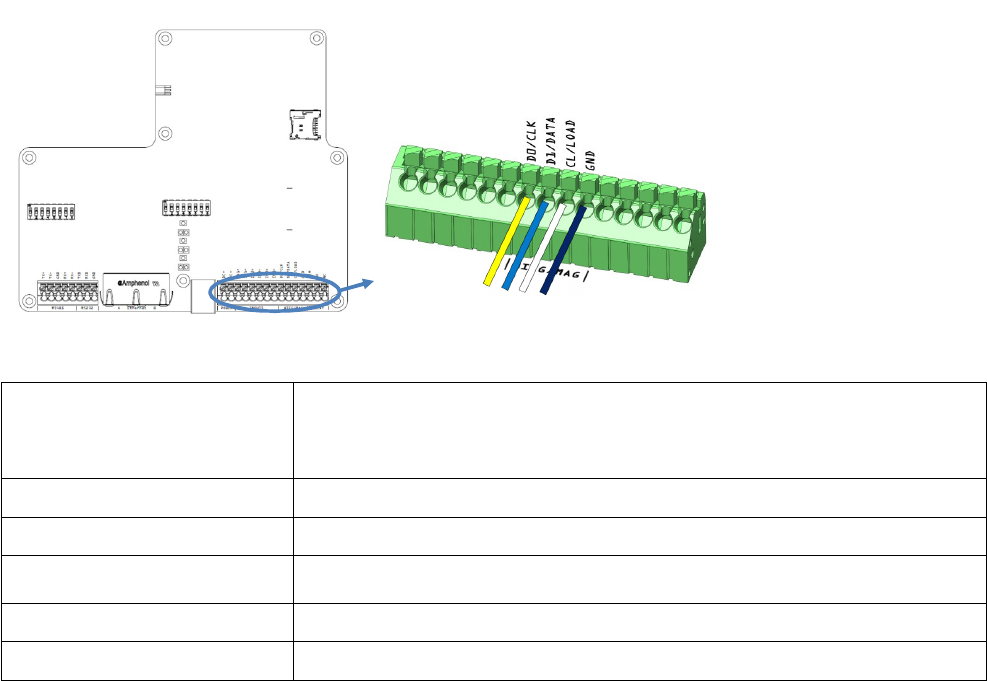
XT-1 Installation Manual 13-111 P01B, 2013-RO-0XX, 2014-01-28
Page 19 of 32
Output
3.10
The XT-1 has 3 open-collector outputs shared with Wiegand/Magstripe available. These are currently
intended for future use and have no specific functionality assigned (other than Wiegand/Magstripe). The
interface has an isolation of 1500VDC.
Figure 17 Output connections, overview and detail
Connections
D0
Output 0 (See
Figure
17
for details)
D1 Output 1
CL Output 2
GND Ground
Applied Voltage Min 1.0 V / Max 30 V
Sink Current Min 0.0 mA / Max 500 mA
Supply
Min 10 V / Max 30 V
Min 3 mA / Max 9 mA
Recommended / Max length 10m / 100m
Wire size 0.5mm
2
/ AWG 20
Table 12 Output connection overview
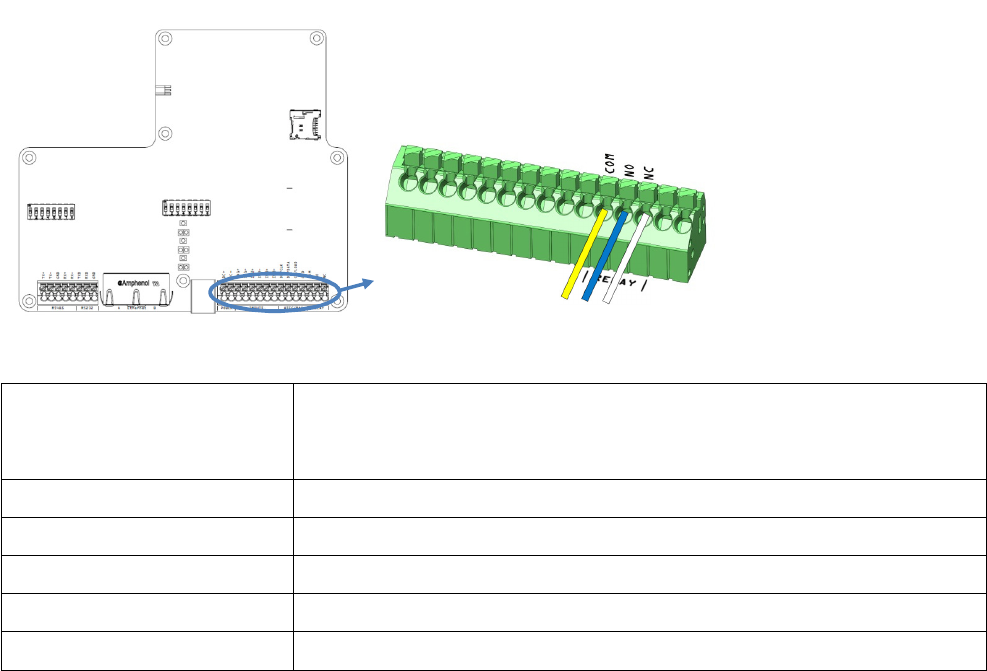
XT-1 Installation Manual 13-111 P01B, 2013-RO-0XX, 2014-01-28
Page 20 of 32
Relay
3.11
The XT-1 has a non-latching relay available. It is typically connected to the logic controlling a barrier, gate
or other object when the reader is in stand-alone operation.
Figure 18 Relay connections, overview and detail
Connections
COM
Common (See
Figure
18
Figure
18
Relay connections, overview
and detailfor details)
NO Normally Open
NC Normally Closed
Switching current Max 2A
Switch voltage Max. 60VDC / 30VAC
Switching capacity: Max. 60W / 62,5VA
Recommended / Max length 10m / 100m
Wire size 0.5mm
2
/ AWG 20
Table 13 Output connection overview
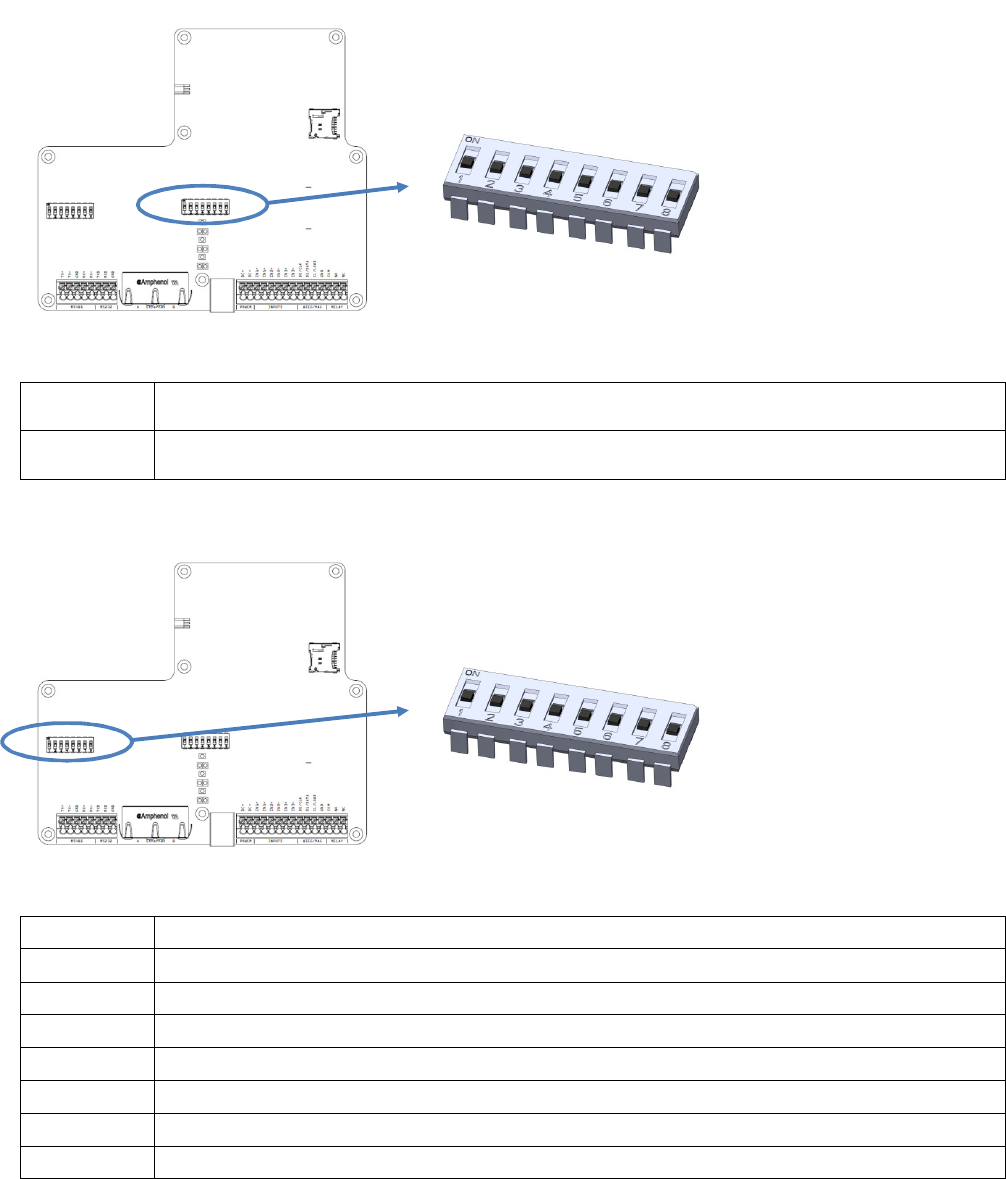
XT-1 Installation Manual 13-111 P01B, 2013-RO-0XX, 2014-01-28
Page 21 of 32
DIP Switches
3.12
Two DIP switches (8 positions) are available for physical configuration of a few major parameters. All other
configurations are done using software. Default state for all switches is ‘Off’.
3.12.1 DIP SW S101
Figure 19 DIP SW S101, overview and detail
Position 1
Firmware upgrade mode. Toggle to ‘On’
and cycle power
before firmware upgrade using
USB. Return to ‘Off’ after upgrade complete.
Position 2 Restore factory default settings. Toggle to ‘On’ and cycle power for complete reader reset.
Return to ‘Off’ after restore complete.
3.12.2 DIP SW S301
Figure 20 DIP SW S301, overview and detail
Position 1 Enable RS485 2-wire mode, TX+ <-> RX+ (always together with Position 2)
Position 2 Enable RS485 2- wire mode, TX- <-> RX- (always together with Position 2)
Position 3 Enable RS485 120
Ω
termination between RX+ and RX-
Position 4 Enable bias RS485 620
Ω
RX+, up
Position 5 Enable bias RS485 620
Ω
RX-, down
Position 6 Enable 1 k
Ω
pull-up D0/CLK
Position 7 Enable 1 k
Ω
pull-up D1/DATA
Position 8 Enable 1 k
Ω
pull-up CL/LOAD
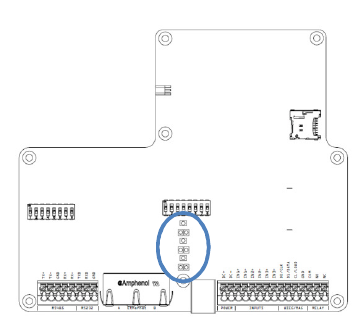
XT-1 Installation Manual 13-111 P01B, 2013-RO-0XX, 2014-01-28
Page 22 of 32
LED and Buzzer
3.13
The XT-1 is equipped with bright LEDs for external signalling. These can indicate red/green/yellow based
on software settings. Default signalling is green for ‘tag read’/’ tag accepted’ and red for ’tag not accepted’
The buzzer is default off, but can be enabled for indicating ‘tag read’/’tag accepted’.
Figure 21 LED, overview
4 Configuration
PC Tool
4.1
A PC tool is available for reader communication and firmware download.
Settings
4.2
The available settings can be found in the PC Tool. Generally these settings includes necessary
configuration for networking, interface output and reader behaviour.
Reset to Factory Default
4.3
To restore the reader back to the factory defaults state toggle the corresponding DIP switch (see §3.12) to
‘On’ and cycle the power. Wait for a few seconds, return the DIP switch to ‘Off’ and then cycle power again.
After a reset to factory defaults all software settings are reverted back to the original state. The IP-address
of the device is again the one printed on the label on the back of the reader.
5 TAGP
The protocol TAGP is available on Ethernet, RS232 and RS485 interfaces.
XT-1 Installation Manual 13-111 P01B, 2013-RO-0XX, 2014-01-28
Page 23 of 32
6 Trouble Shooting
To facilitate trouble shooting, consider the following:
Make sure the XT-1 has correct supply voltage with sufficient current. There is a small green LED
on the electronic board, only visible when the lid of the reader is in open position. A flashing green
light of this LED indicates that power is connected and that the microcontroller is alive.
If using Ethernet communication, make sure that the network connection is ok. There are small
LEDs of the RJ45 socket, only visible when the lid of the reader is in open position. A yellow light
indicates ‘Link’ and flashing yellow light indicates ‘Activity’.
If the software settings might have been set to unclear state or the IP-address mixed up, a reset to
factory default operation is recommended, see §4.3.
Make sure that working and correctly formatted EPC Gen 2 tags are being used.
.
XT-1 Installation Manual 13-111 P01B, 2013-RO-0XX, 2014-01-28
Page 24 of 32
XT-1 Installation Manual 13-111 P01B, 2013-RO-0XX, 2014-01-28
Page 25 of 32
XT-1 Installation Manual 13-111 P01B, 2013-RO-0XX, 2014-01-28
Page 26 of 32
XT-1 Installation Manual 13-111 P01B, 2013-RO-0XX, 2014-01-28
Page 27 of 32
XT-1 Installation Manual 13-111 P01B, 2013-RO-0XX, 2014-01-28
Page 28 of 32
XT-1 Installation Manual 13-111 P01B, 2013-RO-0XX, 2014-01-28
Page 29 of 32
XT-1 Installation Manual 13-111 P01B, 2013-RO-0XX, 2014-01-28
Page 30 of 32
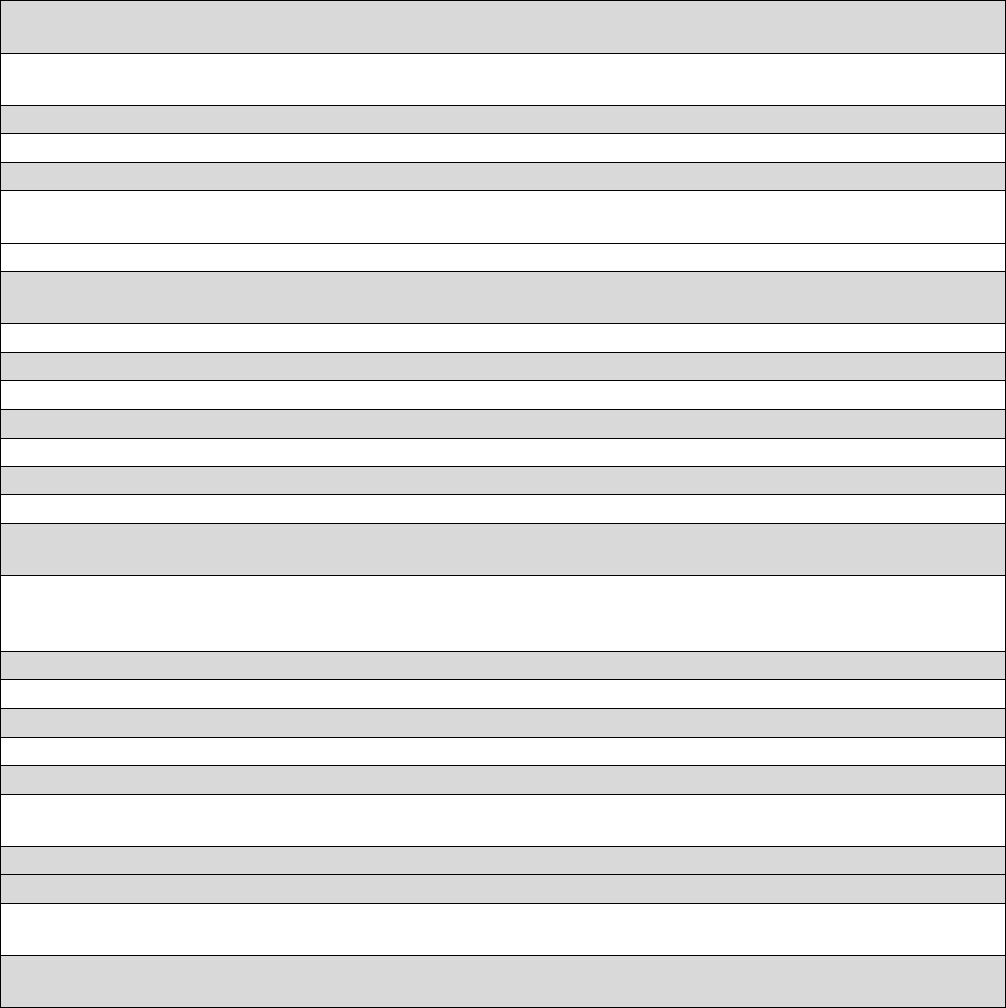
XT-1 Installation Manual 13-111 P01B, 2013-RO-0XX, 2014-01-28
Page 31 of 32
7 Technical Specification
Operating frequencies Area 1: 865.6-867.6 MHz Europe,
Area 2: 902-928 MHz US, Americas
Read range Up to 8 meters (20ft) with TagMaster UHF tags with
SecureMarkID®; Windshield ID-tag and Credit Card ID-tag
Dimensions 300x300x60 mm (11.8x11.8x2.4 in)
Weight 2.3 kg (5.1 lbs)
Protection IP 66
Operating temperature -40°C to +60°C (-40°F to +140° F)
EN 60068-2-1 Ad, En 60068-2-2 Bd, EN 60068-2-14 Nb
Storage temperature -40°C to +85C°C (-40°F to +185°F)
Relative humidity 93%RH @ 65C
EN 60068-2-30
Housing Aluminium housing UL94 certified XENOY™ cover
Power supply 12-24 VDC supply
Power consumption 10W (max 12W)
Output power Area 1 2W (e.r.p.), Area 2 4W (e.i.r.p.)
Input 3 isolated inputs
Output 3 isolated outputs shared with Wiegand/Magstripe
Relay 1 relay output 60VDC, 2A
Interfaces RS232, RS485, Wiegand/Magstripe, 2 pcs Ethernet and
USB service Interface
Certificates CE Certificate according to R&TTE-directive 1999/5/EC and FCC
RoHS Directive 2002/95/EC and 2011/65/EU
WEEE 2002/96/EC
Standards EPC Gen 2 (ISO 18000-6C)
LED indicator Res/Green/Yellow
Communications protocols TAGP and various OEM protocols
Encrypted air interface According to EPC Gen 2 (ISO 18000-6C)
EMC EN 301489-1, EN 301489-3
Radio EN 302 208-1, EN 302 208-2
FCC: CFR 47, Part 15 subpart C, FCC ID: M39XTXX
Safety & health EN 60950-1, EN 60950-22 & 1999/519/EC
Mechanical EN 60068-2-27 Ea, EN 60068-2-64 Fh
Manuals and documentation XT-1 Installation Manual, 13-111
TAGP Manual, 05-172
Part No. Area 1: 152500
Area 2: 152600

XT-1 Installation Manual 13-111 P01B, 2013-RO-0XX, 2014-01-28
Page 32 of 32
Technical Support
Phone: + 46 8 632 19 50
Fax: +46 8 750 53 62
E-mail: support@tagmaster.com
Office Address
TagMaster AB
SE-164 46 KISTA
SWEDEN
Phone: +46 8 632 19 50
Fax: +46 8 750 53 62
E-mail: sales@tagmaster.com
Web: www.tagmaster.com